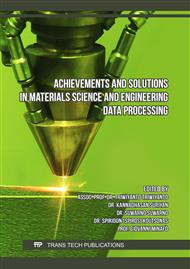[1]
J. Ćwiek, J. Michalska-Ćwiek, Evaluation of hydrogen degradation of high-strength weldable steels, Journal of Achievements in Materials and Manufacturing Engineering, 42 (2010)103-110.
Google Scholar
[2]
Beth A. Kehler, Modeling and experiments to explain the potential dependency of an UHSS to hydrogen environment assisted cracking, Engineering and Applied Science University of Virginia (2008).
Google Scholar
[3]
J. Ćwiek, High strength weldable steels, Mechanical Review, 9 91996) 9-15.
Google Scholar
[4]
N. Eliaz, A. Shachar, B. Tal, D. Eliezer, Characteristic of hydrogen embrittlement, stress corrosion cracking and tempered martensite embrittlement in high-strength steels, Engineering Failure Analysis, 9 (2002) 176-184.
DOI: 10.1016/s1350-6307(01)00009-7
Google Scholar
[5]
M. Nagumo, M. Nakamura & K. Takai, Hydrogen thermal desorption relevant to delayed-fracture susceptibility of high-strength steels, Metallurgical and Materials Transactions A, 32 (2001) 339–347.
DOI: 10.1007/s11661-001-0265-9
Google Scholar
[6]
J.S. Kim, Y.H. Lee, D.L. Lee, K.T. Park, C.S. Lee, Microstructural influences on hydrogen delayed fracture of high strength steels, Materials Science and Engineering A, 505 (2009) 105-110.
DOI: 10.1016/j.msea.2008.11.040
Google Scholar
[7]
S. Takagi, Y. Toji, M. Yoshino, K. Hasegawa, Hydrogen Embrittlement Resistance Evaluation of Ultra High Strength Steel Sheets for Automobiles, ISIJ International, 52 (2012) 316–322.
DOI: 10.2355/isijinternational.52.316
Google Scholar
[8]
S. Bechtle, M. Kumar, B.P. Somerday, M.E. Launey, R.O. Ritchie, Grain-boundary engineering markedly reduces susceptibility to intergranular hydrogen embrittlement in metallic materials, Acta Materialia, 57 (2008) 4148-4157.
DOI: 10.1016/j.actamat.2009.05.012
Google Scholar
[9]
V. Venegas, F. Caleyo, T. Baudin, J.H. Espina-Hernandez, J. Hallen, On the role of crystallographic texture in mitigating hydrogen-induced cracking in pipeline steels, Corrosion Science, 53 (2011) 4204-4212.
DOI: 10.1016/j.corsci.2011.08.031
Google Scholar
[10]
T. Neeraj, R. Srinivasan, J. Li, Hydrogen embrittlement of ferritic steels: observations on deformation microstructure, nanoscale dimples and failure by nanovoiding, Acta Materialia, 60 (2012) 5160-5171.
DOI: 10.1016/j.actamat.2012.06.014
Google Scholar
[11]
M. Koyama, C.C. Tasan, E. Akiyama, K. Tsuzaki, D. Raabe, Hydrogen-assisted decohesion and localized plasticity in dual-phase steel, Acta Materialia, 70 (2014) 174-187.
DOI: 10.1016/j.actamat.2014.01.048
Google Scholar
[12]
I.J. Park, S.M Lee, H.H Jeon, Y.K. Lee, The advantage of grain refinement in the hydrogen embrittlement of Fe–18Mn–0.6C twinning-induced plasticity steel, Corrosion Science, 93 (2015) 63-69.
DOI: 10.1016/j.corsci.2015.01.012
Google Scholar
[13]
X. Li, J. Zhang, Y. Wang, B. Li, P. Zhang, X. Song, Effect of cathodic hydrogen-charging current density on mechanical properties of prestrained high strength steels, Mater Science Engineering A, 641 (2015) 45-53.
DOI: 10.1016/j.msea.2015.06.003
Google Scholar
[14]
Y.H. Fan, B. Zhang, H.L. Yi, G.S. Hao, Y.Y. Sun, J.Q. Wang, E.H. Han, W. Ke, The role of reversed austenite in hydrogen embrittlement fracture of S41500 martensitic stainless steel, Acta Materialia, 139 (2017) 188-195.
DOI: 10.1016/j.actamat.2017.08.011
Google Scholar
[15]
X. Li, J. Zhang, S. Shen, Y. Wang, X. Song, Effect of tempering temperature and inclusions on hydrogen-assisted fracture behaviors of a low alloy steel, Materials Science & Engineering A, 682 (2017) 359-369.
DOI: 10.1016/j.msea.2016.11.064
Google Scholar
[16]
C.A. Zapffe, C. E. Sims, Hydrogen Embrittlement, internal stress and defects in steel, Transactions of Metallurgical Society of AIME, 145 (1941) 225-226.
Google Scholar
[17]
A.S. Tetelman, W.D. Robertson, Direct observation and analysis of crack propagation in iron-3% silicon single crystals, Acta Metallurgica, 11 (1963) 415-426.
DOI: 10.1016/0001-6160(63)90166-4
Google Scholar
[18]
K. Takai, S. Takagi, T. Omura, Recent Progress and Future Directions on Constructing Fundamentals for Hydrogen Embrittlement, Bulletin of the Iron and Steel Institute of Japan, 19 (2014) 911-919.
Google Scholar
[19]
K.S. Lee, J.E. Paeng, K.H. Gu, K.W. Nam, Threshold stress intensity factor of ultra-high strength steel (HV670) containing surface crack by hydrogen assisted cracking and cumulative elastic wave, Journal of Mechanical Science and Technology, 35 (2021) 2441–2447.
DOI: 10.1007/s12206-021-0515-2
Google Scholar
[20]
J.C. Newman, I.S. Raju, An empirical stress intensity factor equation for the surface crack, Engineering Fracture Mechanics, 15 (1981) 185-192.
DOI: 10.1016/0013-7944(81)90116-8
Google Scholar
[21]
Y. Uematsu, T. Kakiuchi, K. Maruchi, T. Teratani, Y. Harada, Effect of DLC film on fatigue behavior in alloy steels with different hardness and inclusion size, Journal of the Society of Materials Science of Japan, 60 (2011) 1097-1103.
DOI: 10.2472/jsms.60.1097
Google Scholar
[22]
C. Jirarungsatian, A. Prateepasen, Pitting and Uniform Corrosion Source Recognition using Acoustic Emission Parameters, Corrosion Science, 52 (2010) 187-197.
DOI: 10.1016/j.corsci.2009.09.001
Google Scholar
[23]
C. Barile, C. Casavola, G.Pappalettera, V. P. Kannan, G. Renna, Acoustic emission signal processing for the assessment of corrosion behaviour in additively manufactured AlSi10Mg, Mechanics of Materials, 170 (2022) 104347.
DOI: 10.1016/j.mechmat.2022.104347
Google Scholar
[24]
H. Bi, H. Li, W. Zhang, L. Wang, Q. Zhang, S. Cao, I. Toku-Gyamerah, Evaluation of the acoustic emission monitoring method for stress corrosion cracking on aboveground storage tank floor steel, International Journal of Pressure Vessels and Piping, 179 (2020) 104035.
DOI: 10.1016/j.ijpvp.2019.104035
Google Scholar
[25]
Y. Oya, Y. Kojima, Effects of acetic acid on pitting corrosion acceleration in corrosion tests of aluminum alloys, Journal of Japan Institute of Light Metals, 62 (2012) 244-248.
DOI: 10.2464/jilm.62.244
Google Scholar
[26]
J. Wei, Effect of Acetic Acid on the Pitting Corrosion of 2Cr12MoV Turbine Steel in Early Condensates Containing Chloride Ions, International Journal of Electrochemical Science, 12 (2017) 3166-3178.
DOI: 10.20964/2017.04.38
Google Scholar


